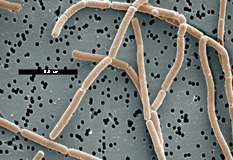Lactobacillus delbrueckii: Difference between revisions
imported>Kiran A. Bharwani No edit summary |
imported>John J. Dennehy mNo edit summary |
||
| Line 1: | Line 1: | ||
{{subpages}} | |||
{{EZarticle-closed-auto}} | {{EZarticle-closed-auto}} | ||
{{Taxobox | {{Taxobox | ||
| Line 7: | Line 6: | ||
| name = ''Lactobacillus delbrueckii'' | | name = ''Lactobacillus delbrueckii'' | ||
| status = | | status = | ||
| image = [[Image:Lacde.jpg|right|thumb|350px|{{#ifexist:Template:Lacde.jpg/credit|{{Lacde.jpg/credit}}<br/>|}} | | image = [[Image:Lacde.jpg|right|thumb|350px|{{#ifexist:Template:Lacde.jpg/credit|{{Lacde.jpg/credit}}<br/>|}}]] | ||
| image_width = | | image_width = | ||
| domain = [[Bacteria]] | | domain = [[Bacteria]] | ||
Revision as of 18:59, 2 April 2008
Articles that lack this notice, including many Eduzendium ones, welcome your collaboration! |
| Lactobacillus delbrueckii | ||||||||||||||
|---|---|---|---|---|---|---|---|---|---|---|---|---|---|---|
| [[image: | ]] | |||||||||||||
| Scientific classification | ||||||||||||||
|
Description and significance
L. delbrueckii is a gram positive bacteria and facultatively anaerobic. It is long, filamentous and non-motile with its cell size ranging between 0.5- 0.8 by 2.0-9.0 millimeters. The environment in which L. delbrueckii thrives the most would be one of relatively low pH, preferring acidic environments making them acid tolerant. L. delbrueckii undergoes obligate homofermtentative metabolism which means it is only able to ferment lactose and no other sugar. L. delbrueckii is found in dairy products such as yogurt, milk, and cheese.
In 1905, Stamen Grigoroy, a Bulgarian doctor, discovered L. delbrueckii subspecies bulgaricus to be a true cause for the existence of natural yogurt. This was an important discovery since it led to further discovery of probiotic effects on humans and animals which improves lactose tolerance and has the ability to stimulate immune responses.
Genome structure
Lactobacillus delbrueckii has a circular genome and is made up of 1,864,998 nucleotides. It has a GC content of 49% and has 2,217 genes. Of the 2,217 genes 1,562 code for proteins such as prtB and the lac operon. These proteins contribute to the homofermentative properties observed in L. delbrueckii. The genes that are encoded to take up and break down lactose are the lacS, lacZ, and lac R genes located within the lac operon. Transport of lactose through the membrane is the primary responisibility of lactose permease that is coded by the lacS gene. On the other hand, the lacZ gene, encodes the enzyme B-galactosidase need to metabolize lactose.
Cell structure and metabolism
Ecology
L. delbrueckii bulgaricus, a subspecie of Lactobacillus delbrueckii is found to have a symbiotic relationship with Streptococcus thermophilus. Together they coexist in starter lactic acid bacteria cultures. The lactic acid that is produced also contributes in preserving milk. L. delbrueckii are also symbiotic with the gastrointestinal tract and vagina of humans.
Pathology
L. delbrueckii is non-pathogenic. It is the source that provides yogurt and cheese.
Application to Biotechnology
Two subspecies of Lactobacillus delbrueckii, L. delbrueckii bulgaricus and L. delbrueckii lactis play a major role in the dairy industry. Fermented yogurt, milk, and cheese are cultured from these two subspecies. If the process of fermentation that occurs through L. delbrueckii bulgaricus and L. delbrueckii lactis came to a halt it would result in a large economic loss. This is why care must be taken to keep the conditions of production constant.
Current Research
Mitogenic effects have been found in specific strains of Lactobacilli. Thes strains have also been found to aid in spleen cell proliferation. YS strains, of L. delbrueckii bulgaricus and L. acidophilus, when heated induce a generation of IgM and IgG by murine spenocytes and was dependent on bacterium concentrations. ELISA and the Fisher's test allowed for the determination of antibody concentrations. In addition, strains YS of the two strains induced lymphocyte proliferation. L. delbrueckii bulgaricus was shown to activate polyclonal B-cells indicated from the maintenance of high antibody levels upon removal of Lactobacilli antibodies.
Lactobacillus delbrueckii are usually not found outside starter cultures in dairy products. Six hundred sixty five plant samples, with the target plant Cornus mas were collected from four sites away from human habitation. Identification of the L. delbrueckii bulgaricus was determined via phenotype analysis, Pulse field gel electrophoresis (PFGE) analysis, and PCR methods. The cultures samples that grew at 45°C were rod shaped, produced D-lactate, generated a DNA fragment of 1065 base pairs with the primers LB1/LLB1, and showed proteolytic activity.
References
